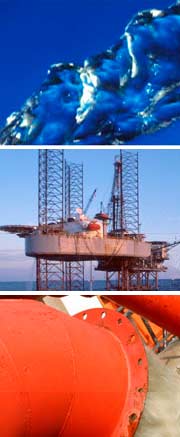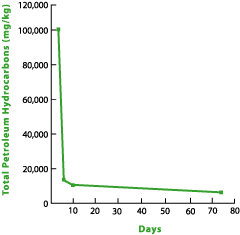 |

 Site Description and Soil Sampling Site Description and Soil Sampling
In situ bioremediation using Kengro Biosorb on a TPH-contaminated tank battery site in southeastern Texas (Needville) has been documented. The tank battery site had an underground pipeline rupture which contaminated soil with crude oil and salt water. The soil was composed of clay, silt, and sand. The site was previously, and continues to be, treated for salt damager with LCA II. Five areas of TPH contamination were identified, totaling approximately 1077 m3 of soil within a 5,400m2 area.
The five areas were covered with a total of 270 kg of Kengro Biosorb evenly distributed, and tilled. All five areas were disked on day 8. Soil samples were analyzed for TPH by gas chromatography using U.S. Environmental Protection Agency (EPA) Method 3540/8015M. Soil samples were tested for TPH prior of Kengro Biosorb treatment, and also on days 5, 10, 13, 19, 24, and 74.
Results and Discussion
An initial soil sample for the site was a composite taken from the five identified areas. This sample was analyzed and determined to contain 102,000 mg/kg TPH. The day 5 sample showed the TPH level to be 14,500 mg/kg, an 86% reduction. On day 10, the TPH was 11,100 mg/kg, an 89% reduction from the initial level. On day 24, five samples were taken at each area of contamination. The average of these TPHs was 8,046 mg/kg, a 92%reduction from the initial TPH. The tank battery site is under the jurisdiction of the Texas Railroad Commission; which requires soil TPH to be no higher than 10,000 mg/kg. TPH degradation at the tank battery site was excellent, with average TPH below the maximum allowable level by day 74.
 |
|